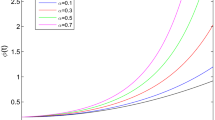Abstract
This paper concerns with a complex system that comprises two subsystems in series configuration. First subsystem has n identical units that are working under k-out-of-n: G policy. All the units are connected in parallel through a switching device, which may be unreliable as and when required. Second subsystem has four identical units that are working under 2-out-of-4: G policy. Failure rates of all the units in both the subsystems are assumed to be constant and follow exponential distribution, while the repair supports general distribution and Goumbel–Hougard copula family distribution. There may be an unpredictable catastrophic failure of the system at any time (t). Failed components are replaced by the available warm standbys and hence are restored as good as new components after repair. A novel efficient technique is used to investigate the system and evaluate availability and reliability of the system, mean time to failure and profit analysis using the supplementary variable technique, Laplace transforms and copula methodology. For such a system, the evaluation of the reliability characteristics is quite complex due to availability of n − k + 1 states for first subsystem as well as a finite series developed during solution unlike as done in the past. Numerical examples are illustrated with graphs for various values of n and k. It can provide a reference for the decision-makers when developing maintenance policies.















Similar content being viewed by others
References
Chen Y, Yang QY (2005) Reliability of two-stage weighted k-out-of-n systems with components in common. IEEE Trans Reliab 54(3):431–440
Dembińska A (2018) On reliability analysis of k-out-of-n systems consisting of heterogeneous components with discrete lifetimes. IEEE Trans Reliab 67(3):1071–1083
El-Damcese M, Shama MS (2020) Reliability analysis of a new k-out-of-n: G Model. World J Model Simul 16:3–17
Eryilmaz S (2013) Reliability of a k-out-of-n system equipped with a single warm standby component. IEEE Trans Reliab 62(2):499–503
Huang J, Zuo MJ, Wu Y (2000) Generalized multi-state k-out-of-n: G systems. IEEE Trans Reliab 49(1):105–111
Jia X, Shen J, Xing R (2016) Reliability analysis for repairable multistate two-unit series systems when repair time can be neglected. IEEE Trans Reliab 65(1):208–216
Krishnamoorthy A, Rekha A (2001) k-out-of-n system with repair: T-policy. Korean J Comput Appl Math 8(1):199–212
Kumar P, Gupta R (2007) Reliability analysis of a single unit M|G|1 system model with helping unit. J Comb Inf Syst Sci 32(1–4):209–219
Kumar P, Sirohi A (2011) Transient analysis of reliability with and without repair for k-out-of-n: G systems with three failure modes. Int J Math Comput Sci 2(1):151–162
Li X-Y, Liu Y, Chen CJ, Jiang T (2016) A copula-based reliability modeling for non-repairable multi-state k-out-of-n systems with dependent component. Proc Inst Mech Eng Part O J Risk Reliab 230:133
Liang X, Xiong Y, Li Z (2010) Exact reliability formula for consecutive k-out-of-n repairable systems. IEEE Trans Reliab 59(2):313–318
Moghaddass R, Zuo MJ, Wang W (2011) Availability of a general k-out-of-n: G system with non-identical components considering shut-off rules using quasi-birth-death process. Reliab Eng Syst Saf 96:489–496
Moustafa MS (1996) Transient analysis of reliability with and without repair for k-out-of-n: G systems with two failure modes. Reliab Eng Syst Saf 53:31–35
Munjal A, Singh SB (2014) Reliability analysis of a complex repairable system composed of a 2-out-of-3: G subsystem and a series subsystem connected in parallel. J Reliab Stat Stud 7(5):19–39
Park M, Pham H (2012) A generalized block replacement policy for a k-out-of-n system with respect to a threshold number of failed components and risk costs. IEEE Trans Syst Man Cybern A Syst Hum 42(2):453–463
Poonia PK, Sirohi A (2020) Cost benefit analysis of a k-out-of-n: G type warm standby series system under catastrophic failure using copula linguistics. Int J Reliab Risk Saf Theory Appl 3(1):35–44
Raghav D, Poonia PK, Gahlot M, Singh VV, Ayagi HI, Adbullahi AH (2020) Probabilistic analysis of a system consisting of two subsystems in the series configuration under copula repair approach. J Korean Soc Math Educ Ser B Pure Appl Math 27(3):137–155
Ram M, Singh SB, Singh VV (2013) Stochastic analysis of a standby complex system with waiting repair strategy. IEEE Trans Syst Man Cybern Part A Syst Hum 43(3):698–707
She J, Pecht MG (1992) Reliability of a k-out-of-n warm-standby system. IEEE Trans Reliab 41:72–75
Singh VV, Poonia PK, Adbullahi AH (2020a) Performance analysis of a complex repairable system with two subsystems in series configuration with an imperfect switch. J Math Comput Sci 10(2):359–383
Singh VV, Poonia PK, Rawal DK (2020b) Reliability analysis of repairable network system of three computer labs connected with a server under 2- out- of- 3 G configuration. Life Cycle Reliab Saf Eng. https://doi.org/10.1007/s41872-020-00129-w
Taghipour S, Kassaei ML (2015) Periodic inspection optimization of a k-out-of-n load-sharing system. IEEE Trans Reliab 64(3):1116–1127
Tian Z, Zuo MJ (2009) The multi-state k-out-of-n systems and their performance evaluation. IIE Trans 41:32–44
Wu YQ, Guan JC (2005) Repairable consecutive- k-out-of-n: G systems with r repairman. IEEE Trans Reliab 54(2):328–337
Author information
Authors and Affiliations
Corresponding author
Additional information
Publisher's Note
Springer Nature remains neutral with regard to jurisdictional claims in published maps and institutional affiliations.
Rights and permissions
About this article
Cite this article
Poonia, P.K., Sirohi, A. & Kumar, A. Cost analysis of a repairable warm standby k-out-of-n: G and 2-out-of-4: G systems in series configuration under catastrophic failure using copula repair. Life Cycle Reliab Saf Eng 10, 121–133 (2021). https://doi.org/10.1007/s41872-020-00155-8
Received:
Accepted:
Published:
Issue Date:
DOI: https://doi.org/10.1007/s41872-020-00155-8




